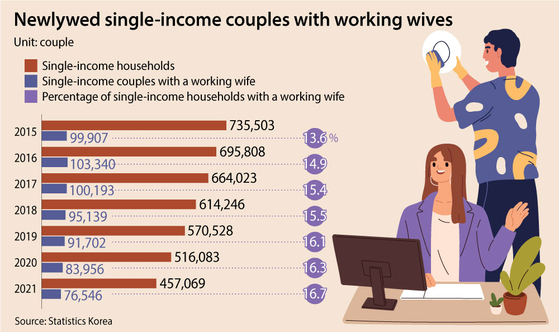In Korea, more women are becoming breadwinners

In Korea, a single-income family traditionally means a working father and a stay-at-home mom.
Cut to 2023, and it isn't uncommon now to see single-income families with the mother as the breadwinner.
A 34-year-old office employee working in a mid-sized firm in Seongnam, Gyeonggi, pays the bills these days. She is in her third year as the sole breadwinner after the Covid-19 wave forced her husband out of work at the end of 2020.
Her husband now does the housekeeping.
“I don’t think people around us see us strange,” the office worker told the JoongAng Ilbo. “Although my earnings are not high, they are still enough to make a living. I delayed motherhood because of the work.”
The number of single-income families with working wives and stay-at-home husbands is on the rise in Korea. This comes as the wages of working women increase along with their status. Changing views on gender roles help in the acceptance of stay-at-home men.
According to the latest data by Statistics Korea, for 76,546 newlyweds couple — defined as being in the first through fifth year of marriage — the wives were the breadwinners in 2021. That is 16.7 percent of all single-income newly-wed couples.
In 2015, when Korea started compiling these figures, the percentage of working wives in one-income households stood at 13.6 percent, or 99,907. But that continued to increase — 16.1 percent in 2019, 16.3 percent in 2020 and 16.7 percent in 2021 — though over the past six years, the total number of newly-wed couples shrunk from 1.47 million to 1.1 million, with the number of single-income couples itself decreasing as well.
The reason behind the increase in the number of working wives can be attributed to the rise of female labor force participation. The population of women who are economically active was 11,426, and the female labor force participation rate was 51.9 percent of the total female, in 2015. The figures raised to 12,186 and 53.3 percent, respectively, in 2021. Over the same period, the male labor force participation rate decreased from 74.1 percent to 72.6 percent.
Meanwhile, it was found that one-income households in which wives worked were more likely to have no children than one-income households with working husbands or dual-income households. As of 2021, 56 percent of working wives in one-income households didn’t have any kids — compared to 36.8 percent child-free one-income households with the husband being the breadwinner, or 50.4 percent among dual-income couples with no kids.
The figures suggest that women who have greater financial responsibilities are less likely to have a child.
“Even if more women have become the breadwinners of a single-person household, such statistics are proof that women are still forced to play more roles in childcare than men,” said You Hye-mi, a professor at Hanyang University’s Division of Economics and Finance. “In order to raise the fertility rate, childhood care should be offered not only in the infant stage but also for primary school, and that way we can prevent career prevention.”
BY JEONG JIN-HO, SEO JI-EUN [seo.jieun1@joongang.co.kr]










with the Korea JoongAng Daily
To write comments, please log in to one of the accounts.
Standards Board Policy (0/250자)